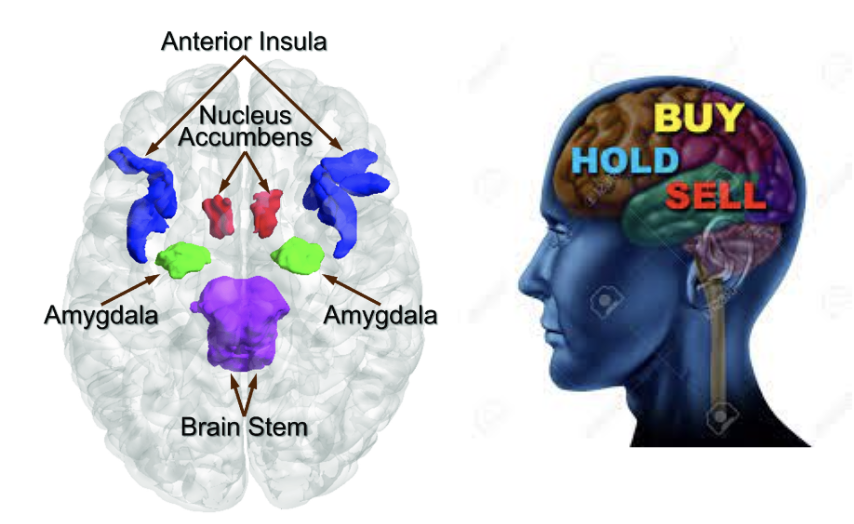
“Neuroforecasting”: Using Brain Data to Predict Stock Market Fluctuations
By Anjali Sadarangani
The brain’s duality of incorporating higher order thinking and emotional processing in decision-making is central to coordinated large-scale activities. For example, take the stock market, a space that relies on human decision-making in a competitive and dynamic environment. With stock market prices hitting new lows in 2022, the choices and factors affecting such decisions have since increased in significance. Anticipatory affect, the emotional states that individuals feel when predicting outcomes, is pivotal to the price fluctuations observed in the stock market. In 2021, a series of two experiments were conducted to examine whether anticipatory affective brain activity could forecast aggregate changes in stock markets.The overlap of medical and space technologies necessitates low-light sensitivity and high-quality imagery in order to locate very specific cells or stars. These specifications produce detailed photos across short time durations, which is made possible by detectors at low frequencies to contrast against background stars or cells. One of the earliest examples of astronomy cancer imaging is through a biopsy method called stereotactic fine-needle biopsies, in which a digital spot mammography method uses CCD images developed by NASA for the Hubble Space Telescope (HST) to image breast cancer cells. Used in conjunction is the image processing algorithm of the HST, a technology used to execute biopsies in breast tissue. Usually utilized for mammography, specific patterns and clusters of breast cancer indicators are filtered in the same way the HST collects data on particular stars in a supermassive cluster. These biopsies are also performed for brain, lung, and liver cancers.
Unpredictable variation in systemic investor preference (Camerer, 2003) and a variety of other challenges make it difficult for investors to attempt to forecast changes in the stock market. However, previous neuroimaging suggests neural predictors of individual choice that forecast aggregate choice responses (Falk et al.,2012; Knutson, Genevsky, 2018), such as those observed in laboratory simulations with music and video clips (Berns and Moore, 2012; Tong et al., 2020). The challenge with investigating “neuroforecasting” in the stock market lies in the interpersonal competitive and dynamic interactions (De Martino et al., 2013). Building on the existing hypothesis that anticipatory affect precedes risk assessment (Bechara et al.), two brain regions were of particular interest in this study–the nucleus accumbens (NAcc) and the anterior insula (AIns). The NAcc is associated with positive aroused affect and approach behavior, whereas the AIns is a brain region associated with avoidance behavior. The researchers hypothesized that increased demand for stock and associated price increases would be positively correlated with nucleus accumbens activity while decreased demand for stocks would be positively correlated with anterior insula activity.
Study participants engaged in two experimental trials: the first experiment involved an asset pricing task and a behavioral investment allocation strategy, and the second experiment involved gambling. Asset pricing was paired with magnetic resonance imaging and based on stock trend lines of fourteen stocks from a trading period in 2015. Participants observed trend lines with twenty updates and then were given the choice of investing in each stock. Based on the accuracy of each decision, subjects were either awarded or penalized a dollar to simulate stock market gains and losses. In the second trial, participants imagined a hypothetical scenario where they could buy, sell, or hold more of a stock. They then rated their confidence with these choices. Similar to the first trial, participants were appropriately rewarded and penalized based on their decisions. fMRI data combined with brain data on predefined volumes of interest (VOIs) previously shown to be involved in finance risk-taking were investigated. Additionally, a neural model of regression analyses with brain activity and stock price dynamics along with a combined model of used neural variables in conjunction with choice behavior and stock indicators were constructed for analysis.
Some of the key findings from this study were as follows:
1) Subject choice behavior could not significantly forecast the next-day stock price.
2) For experiment 1, the neural model indicated that average NAcc activity positively forecasted next-day stock price. The combined model indicated that prior price movement, NAcc activity, and the interaction of prior movement with AIns activity effectively forecasted next-day stock price.
3) For experiment 2, the neural model did not show significant associations between NAcc activity and stock price. The combined model, however, did show significant interaction with AIns activity.
4) Whole brain analyses demonstrated that NAcc activity increased for both gains and avoided losses. NAcc activity decreased from losses and missed gains.
5) AIns activity could forecast stock price inflections.
Overall, the findings suggested that neural activity associated with anticipatory affect could forecast aggregate choice. Some limitations of this study included a constrained set of stock scenarios and the use of historical data. While there is potential for further research, the studies conducted as of now provide an accurate prediction tool for the stock market.
References
- Bechara A, Tranel D, Damasio H, Damasio AR (1996) Failure to respond autonomically to anticipated future outcomes following damage to prefrontal cortex. Cereb Cortex 6:215–225. 10.1093/cercor/6.2.215
- Berns GS, Moore SE (2012) A neural predictor of cultural popularity. J Consum Psychol 22:154–160. 10.1016/j.jcps.2011.05.001
- Camerer CF (2003) Behavioral game theory: experiments in strategic interaction. Princeton, NJ: Princeton UP.
- Falk EB, Berkman ET, Lieberman MD (2012) From neural responses to population behavior: neural focus group predicts population-level media effects. Psychol Sci 23:439–445. 10.1177/0956797611434964
- Knutson B, Genevsky A (2018) Neuroforecasting aggregate choice. Curr Dir Psychol Sci 27:110–115. 10.1177/0963721417737877
- Stallen, M., Borg, N., & Knutson, B. (2021, April 7). Brain Activity Foreshadows Stock Price Dynamics. The Journal of neuroscience : the official journal of the Society for Neuroscience. https://www.ncbi.nlm.nih.gov/pmc/articles/PMC8026346/#B7
